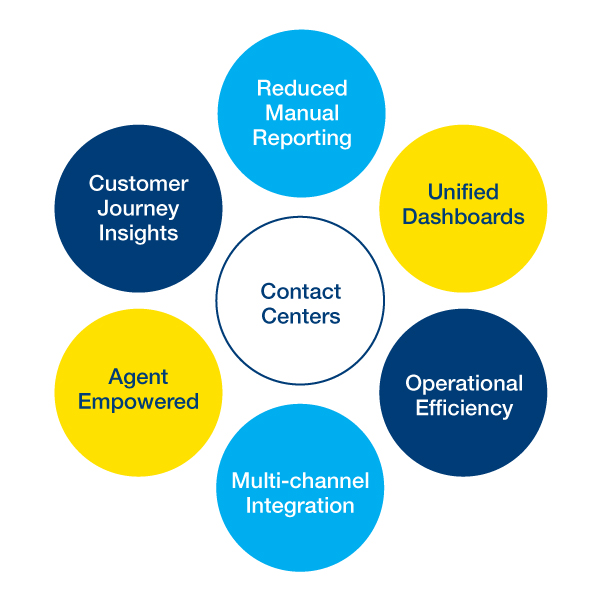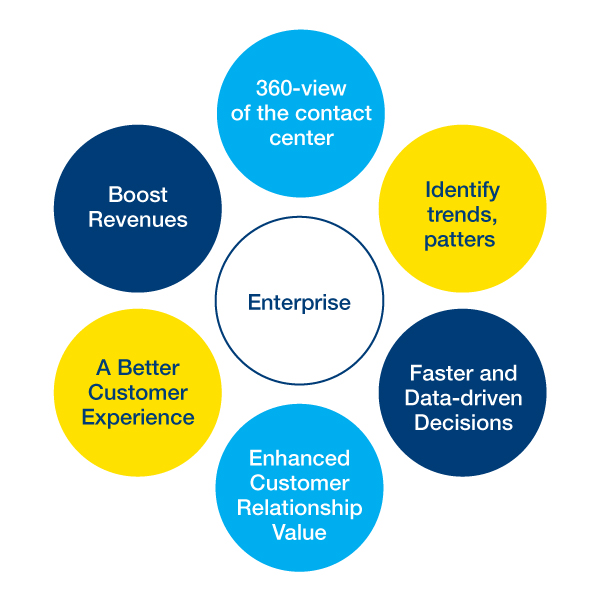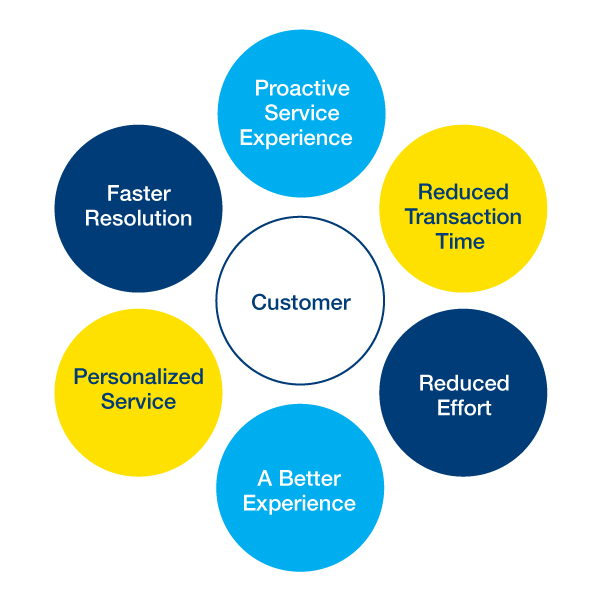Driven by ruthless competition, brutal cost pressures and soaring customer needs, the role of the contact center has been constantly evolving over the last few years. Progressive enterprises are seeing contact center analytics as a strategic and experience-based driver of business growth than rather an enabler of customer service.
CEOs are relying on contact centers to keep a finger on the pulse of customers; they expect agents to broaden their horizon, from merely reacting to service grievances to proactively driving customer engagement and brand experience. With contact centers donning the hat of a data nerve center, it seems only natural that CEOs have such expectations.
Yet, the reality is that contact centers are plagued by information overload and disparate data silos. On one end, they face customers who have a zero tolerance towards mediocre or inconsistent experience. On the other – their CEOs want nothing short of an outstanding experience to be delivered. Contact centers end up being awkwardly ‘stuck in the middle’. However, with technologies making serious strides in mining, segregating and delivering large amounts of data, they now have the firepower to win over both sides.
The need for deep-dive contact center analytics and customer care analytics have become more critical than before; one that captures actionable insights from the wealth of data that customers leave behind during their everyday interactions.
Let us take a quick look at how contact center can leverage analytics to truly live up to the expectations of their leadership teams, as well as their end customers.

Understanding contact center analytics:
Simply put, contact center analytics looks to leverage ‘all customer data’ to drive enterprise performance and informed decision-making. It can help in identifying trends, reducing churn, gaining cross-channel intelligence, and giving managers the right insights to drive business growth while ensuring operational efficiency.
So, what are the outcomes that contact center analytics can drive? What are the customer care analytics use cases? Let us weigh it from three perspectives – the contact center, the customer and the enterprise.
Benefits from analytics for the contact center
- Multi-channel integration: Seamless bi-directional integrations with core enterprise applications such as CRM, ERP, and other data warehouses.
- Customer journey insights: Leverage a 360-degree view of customers’ journeys across all channels and transactions to provide a unified omni-channel customer experience.
- Empowered agents: Understand customer preferences, harness journey insights, receive alerts when incidents happen, and ensure customer receive a superior experience.
- Reduced manual contact center reporting: Bid goodbye to manually extraction and consolidation of data, reduce manual effort for reporting by 60%, and dynamically generate ad-hoc reports when required.
- Gain operational efficiency: Keep an eye on critical contact center metrics and KPIs. Measure, monitor and manage everything that matters.

Benefits from analytics for the enterprise
- Get 360 -degree view of the contact center: Find answers to the what, why and how questions about the day-to-day contact center operations.
- Identify trends and patterns: Discover customer trends and anomalies in patterns and drill into the data for deeper detail while preserving the context.
- Faster and data-driven decision making: Integrate self- contained siloes through unified dashboard, use multi-channel customer intelligence integrated with quality monitoring systems, workforce management solutions and enterprise applications.
- Boost revenues with cross-sell and up-sell: Drive additional revenues by identifying contextual cross-sell, and upsell opportunities – using Next Best Actions.
- Enhance customer relationship value: Reduce customer churn, improve customer engagement and create targeted campaigns based on customer lifetime value.
- Offer a better customer experience: Improve the overall customer experience by offering the right support, to the right customer, in the right channel, at the right time.

Benefits from analytics for the customer
- Get personalized service: Get a consistent, seamless, and hyper-personalized omni-channel experience across multiple channels and touchpoints.
- Gain faster resolutions: Find faster resolutions to complex issues without having to suffer long holding time, painful transfers and get First Contact Resolutions.
- Reduced transaction time: Gain real-time responses to current issues based on journey insights.
- Reduced customer effort: Use the minimum effort necessary to achieve the best possible outcome.
- Gain proactive service: Get help before you ask for it; discover solutions to problems even before they arise.

Critical components of the contact center analytics stack:
There is no perfect blueprint for implementing contact center analytics. Building the components of this stack is similar to the requirements of any conventional data environment. But, it is important for enterprises to take an outside-in approach – considering their customers’ journeys across multiple touchpoints – rather than looking at it as an IT investment. Each of the components needs to closely align with the unique challenges and business needs, treating it as a multiyear technology and process initiative. Some of the most common elements include:
a) Sentiment analytics: It has always been important for enterprises to understand their customers’ emotions. In today’s digital world, they should have the ability to interpret and act on it too. Understanding, anticipating and leveraging customer emotions with sentiment analysis – especially based on their social media posts can help them to respond better.
b) Customer effort analytics: Analyzing customer effort helps in increasing customer loyalty, customer retention and reduced cost of service. Many analytics platforms today allow users to slice and dice customer effort scores across regions, products and categories; enabling them to identify products or categories that cause a spike in the effort.
c) Customer journey analytics: Deciphering a customer’s journey is key to empowering agents to deliver flawless customer experience and achieve operational efficiency. Journey insights allow enterprises to analyze step-by-step the interactions across branches, voice, email, chat, web, social or any other touchpoint overtime to complete a task.
d) Contact center predictive analytics: Powered by statistical and machine learning models, predictive analytics helps enterprises to foresee what is best for the customer. Based on transactional, historic and demographic data, it enables enterprises to offer the right Next Best Actions. Agents too can understand preferences, identify cross-sell, and upsell opportunities while providing event-based help to customers.
e) Contact center next best action analytics: Next Best Action engines extend alternative actions to a customer during an interaction. Enterprises, looking to improve the effectiveness of these engines, need a dashboard to analyze the effectiveness of business rules. That is exactly what an effective contact center analytics software delivers. Users can perform analysis across customer segments, products and channels and drive continuous improvement by measuring rule effectiveness.
f) Contact center performance analytics: Contact center metrics analytics and reporting in one of the key expectations from any operation manager. They need to constantly keep an eye on critical contact center metrics and KPIs to measure operational performance. Contact center performance analytics platforms integrate data from multiple customer channels and enterprise systems – providing contact centers managers, operations, technology and business a 360-degree view of the contact center.
Choosing the right contact center analytics software:
Irrespective of what a vendor tells you or how easy the deployment may appear to be, the fact remains that any enterprise’s contact center analytics platform will be a combination of multiple solutions, products or platforms. Currently, there is no single contact center analytics platform that is best-fit and budget-friendly for all business use cases; that can be implemented without any additional training or skills.
To simplify your selection process, here are a few must-have features, functions and factors to consider:
1. Starts with the customer in mind
Like most analytics investments, the end-game must be factored in, right from the start. Imagine spending hundreds of thousands of dollars to procure a solution and clocking immeasurable hours in implementing it – only to realize that it does not improve the overall customer experience. Simply put, it should make it easier to keep customers happy. Everything else can then be worked backward from thereon.
Question to ask: How does it make my customers life easier?
2. Go multi-channel or go home
Any contact center analytics product or a contact center analytics software worth its salt will first look to integrate contact centers with core enterprise applications and data warehouses to gain holistic insights. It should integrate multiple sources of channel data such as IVR, ACD, email, chat, and social to help enterprises track, monitor and analyze critical contact center KPIs. It should also enable omni-channel customer experience, which is connected, seamless and unified.
Question to ask: Does it allow multi-channel and cross-channel analytics natively?
3. Offers you the ability to interact with data
An ideal contact center analytics software should allow DIY reporting and advanced UX capabilities to empower agents to create ad hoc reports, use historical data on the fly, change filters – all with an advanced and simple-to-use GUI. It should also offer prebuilt contact center data analysis templates. This will lead to a greater flexibility and lesser dependency on report developers. Agents should also be able to choose from an array of graphical formats to display results, see trends and anomalies, and drill into the data for deeper detail while preserving the context.
Question to ask: Does it make analytics so simple that even non-technical business leaders can use it with no IT-dependencies?
4. A single dashboard for faster decision making
One of the biggest challenges in the contact center is that lack of an integrated view of all critical contact center KPIs. Therefore, the right solution should integrate self- contained siloes through a unified dashboard. Information from different customer channels should be integrated with quality monitoring systems, workforce management solutions and enterprise applications to better understand what is happening in the contact center – thereby enabling faster and more effective decision-making.
Question to ask: Does it offer a single dashboard to answer the why, what and how questions about the contact center and the customer’s journey across all channels?
5. Reduces manual reporting at least by 60%
Contact center operations managers often find themselves manually extracting data from multiple datasheets and consolidating reports. An ideal solution must take contact center reporting and analytics to a whole new level. It should result in cutting down manual reporting efforts at least by an estimated 60% if not 100%. It should also not require additional training – enabling current resources to generate sophisticated reports – faster, smarter and easier.
Question to ask: Does it put an end to wasting hours in manual reporting and consolidation?
6.Allows you to dream big
Contact centers are on the frontline of an increasingly-complex customer experience battlefield. Therefore, an ideal contact center analytics software must be a meeting point of cutting-edge technological innovation and meeting customer/stakeholder expectations. It should allow seamless integration with emerging Artificial Intelligence technologies such as Chatbots, Virtual Assistants, Virtual Reality, and Augmented Reality.
Question to ask: Does it future-proof your contact center/ customer experience investment?
According to a MarketsandMarkets research report, there are about 25 leading vendors in the contact center analytics market. These vendors have been placed into 4 categories based on their performance as visionary leaders, innovators, emerging companies, or dynamic differentiators.
Conclusion:
Enterprises must recognize the need to deliver data-driven, seamless omni-channel experience to customers more than ever before. So, before you the rush to implement new technologies and add new channels, ensure that your investments do not result in just a creation of multiple technology layers that creates a complex contact center. Instead, make all the right moves so that your contact center analytics keep your customers coming back.
- Categories
- Tags
- Archives
Subscribe For Updates
Get the Servion Blog updates in your inbox.
Recommended For You
- Average Handling Time (AHT): still the lynchpin of contact centers management?
- Why is customer service still a challenge in today's business landscape?
- The Evolution of Remote Call Centers: Enhancing Customer Experience in a Virtual World
- From Interactions to Journeys: How to Start Managing CX Holistically
- Why isn’t anyone talking about contact center reporting?











